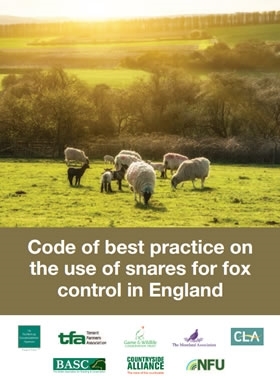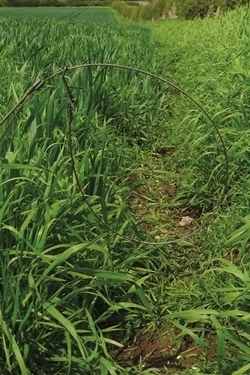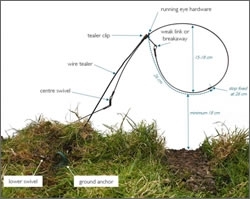 By Jonathan Reynolds, GWCT Head of Predation Control Studies
By Jonathan Reynolds, GWCT Head of Predation Control Studies
Today sees the publication of the Code of best practice on the use of snares for fox control in England.
Drafted to update the 2005 Defra Code, it is the result of a collaboration of rural organisations: Game & Wildlife Conservation Trust (GWCT), Tenant Farmers Association (TFA), CLA, BASC, Countryside Alliance (CA), NFU, National Gamekeepers Organisation (NGO), and the Moorland Association (MA).
A foreword by the current Under Secretary of State, Dr Thérèse Coffey, acknowledges the utility of snares, but also underlines their capacity to cause suffering if used carelessly. She stresses the importance of seeking the highest possible standards of animal welfare by promoting best practice.
The new Code of Practice signals the commitment of this broad range of organisations to that principle. Their aim is to see that best practice is adopted by all those who use snares to carry out fox control in the English countryside.
A Code of Practice covers working practices that are not captured in legislation, and perhaps cannot be. Legislation lays down the bare essentials. Issues that need more space to explain, and advice that may need to be updated in the light of further research or changing circumstances, are better handled through a Code of Practice.
Legislation defines offences while a Code of Practice promotes best behaviour. So the Code isn’t mandatory, except in the sense that you are responsible for the welfare of the animal you catch (under the Animal Welfare Act 2006).
After the 2005 Code of Practice was published it was promoted by organisations associated with game management or shooting to gamekeepers, farmers, and land managers. It was assumed that most snare-users were involved in the game management sector; but in 2009 when GWCT surveyed landholdings across England and Wales on behalf of Defra, we found almost as many farmers using snares for fox control as gamekeepers. So promotion of the Code hitherto had completely missed half of the practitioners, and its influence on the other half was less than total.
 As a group, gamekeepers were certainly more familiar with best practice recommendations, but in both groups working practices persisted that could only fuel the bad press snares had received. Arguably that first Code wasn’t persuasive enough. Its recommendations had been based on expert opinion, but they lacked the solid support of research evidence.
As a group, gamekeepers were certainly more familiar with best practice recommendations, but in both groups working practices persisted that could only fuel the bad press snares had received. Arguably that first Code wasn’t persuasive enough. Its recommendations had been based on expert opinion, but they lacked the solid support of research evidence.
Possibly snare users already considered themselves to be experts and did not feel compelled to change their behaviour. And one almost inescapable reason for not following the Code fully in 2009 was that there was no still no fox snare available ‘off-the-shelf’ that conformed to Code of Practice recommendations.
But much has changed since 2005. GWCT has done a huge amount of research into: the use of fox snares by different interest groups; snare design; operating practices; selectivity; and the condition of captured animals. We used our expertise to design a snare with reduced risk of catching non-target species.
It was as good as we could make it – a snare for professionals – and we involved professional gamekeepers to field-trial it. Their records showed that our improvements greatly reduced the risk to non-targets. And they confirmed on a larger scale what Defra had already concluded: that animals held in well-designed snares are unlikely to be injured unless they entangle the snare with some nearby fixed obstacle.
Entanglement can be completely avoided through careful choice of snare location. In other words, the acceptability of snaring depends heavily on both good hardware and good operating practices.
So although the 2016 Code of Practice isn’t radically different from the 2005 one, it is now founded on solid evidence, and is therefore authoritative. We know that by following it, practitioners can largely eliminate the dismal outcomes that have made the use of snares so controversial.
Improved Code-compliant snares – including a production version of the GWCT design – are out there on the marketplace, and they don’t cost very much more. Using well-designed snares AND following best practice as outlined in the Code brings snaring within the ‘acceptable’ range of international humaneness standards.
Together, the rural organisations behind the new Code can push and promote it where it is needed. We can run training courses, and advise employers as well as practitioners to attend one. But ultimately we can’t oblige anyone to follow the Code.
So our message to snare users is that matters are in their own hands. If best practice becomes normal practice, there is a fair argument: snares have a utility that can’t currently be replaced, with a humaneness that equals that of other wildlife control methods. If yesterday’s careless practices remain widespread, it is unlikely that any future Government will resist the growing pressure to ban snares completely.
You can download the new Code here.
Get your FREE fox snaring guide from the GWCT team
Simply enter your email address below to download your essential free guide.
 What's inside your FREE fox snaring guide
What's inside your FREE fox snaring guide
✓ Fox control: Is it important?
✓ What are the alternatives to snaring?
✓ The main components of a well-designed snare
✓ Fox snares: Hardware vs practice
✓ Key controversies
* By submitting your email address you are giving your consent to receive emails from the GWCT about our work with the opportunity to unsubscribe at any time.